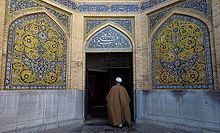Feyziyeh School
| Feyziyeh School مدرسه فیضیه | |
|---|---|
 | |
| Religion | |
| Affiliation | Islam |
| Location | |
| Location | Qom, Iran |
| Architecture | |
| Type | School |
| Style | Iranian |
| Completed | 1792 |
Feyziyya School (
Ayatollah Ruhollah Khomeini
denouncing the Shah, after which he was arrested.
Background
The Feyziyya school was founded in
Shah Tahmasp.[1]
A school by the name of Astana existed at the site, from the 6th century until the 11th. Reconstruction was carried out under the Safavids and the school was renamed Feyziyya.[2]
The school was rebuilt and extended under Fath-Ali Shah in 1792. The school has 40 rooms on the first floor, 4 long veranda, 12 stalls and a square pool.[3][4]
History
Opposition to the White Revolution
In 1963
Mohammad Reza Shah announced a program of reform he labeled the White Revolution.[5] Members of the Iranian clergy were angered by proposed land reforms and protested against these changes. The Shah himself traveled to Qom and announced the clergy black reactionaries worse than the red reactionaries and a hundred times more treacherous than the (communist) tudeh party during his speech. On 26 January 1963, he held a referendum to get the appearance of public support in which 5.6 million against 4.1 people vote for the reformation. The referendum was a good excuse for the government to take tougher practical action against the clergy and on 22 March 1963, coinciding with the death day of Ja'far al-Sadiq, the Shah's guards attacked Feyziyeh School and kill students and people.[6][7] According to Daniel Brumberg, the regime persuaded the thugs to attack the students of Feyziyeh School.[8]
In response Ayatollah Ruhollah Khomeini announced the new year of 1963 as a day of public mourning.[9]


Khomeini's sermon
On the afternoon of June 3, 1963,
Fatimah al-Ma‘sumah
, the Astana square and the surrounding were full of people.
On 5 June 1963 at 3 am, two days later, police and commandos entered Khomeini's home in Qom and arrested him.Movement of 15 Khordad.[10]
Registration in the National Monument
The Feyziyya school was registered as one of Iran's national monuments on January 29, 2008.[13]
See also
References
- ^ Naser al-Sharia, Muhammad Hussain (1971). Tarikh-e Qom. تاریخ قم، یا، حریم مطهر بانوی عالیقدر اهل بیت عصمت و طهارت حضرت فاطمه معصومه سلام الله علیها. Tehran: Dar-al-Fekr. p. 155.
- ^ Mudarres Tabatabaee, Sayyid Hussain (1971). "Madreseh Astaneh Mughaddaseh". Vahid. 88 (88): 126–129.
- ^ Zendeh-Del, Hussain (2000). Ostan Qom. Jahangardan va Irangardan. p. 57.
- ^ "Qom". uppersia.
- ^ [1] Archived 24 December 2007 at the Wayback Machine
- ISBN 978-8126909414.
- ISBN 978-9675062254.
- ISBN 978-0226077574.
- ISBN 9780813372938.
- ^ a b "Moin, Khomeini". 2000. p. 104.
- ^ "Nineteen Years on Departure of Islamic Republic Founder". Archived from the original on 18 July 2021. Retrieved 21 September 2019.
- ISBN 978-0-415-66969-6.
- ^ "Athar Bastani va Tarikhi". Retrieved 15 May 2015.

